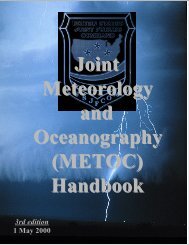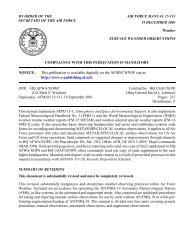Air and Space Weather Operation - IHMC Ontology and Policy ...
Air and Space Weather Operation - IHMC Ontology and Policy ...
Air and Space Weather Operation - IHMC Ontology and Policy ...
You also want an ePaper? Increase the reach of your titles
YUMPU automatically turns print PDFs into web optimized ePapers that Google loves.
AFMAN15-129 21 JUNE 2004 211.8.1.7.3. MISSIONWATCH (i.e. amendment criteria, dissemination of amendments).1.8.1.7.4. Pilot-to-Metro Service (i.e. radio frequency, number for phone patches, limitations).1.8.1.8. OWS-CWT Interactions (Reference Figure A2.2.).1.8.1.8.1. OWS Responsibilities (e.g., information, products, services).1.8.1.8.2. CWT Responsibilities (e.g., information, products, services).1.8.1.8.3. Obtaining weather information when the CWT is unavailable (i.e. closed, deployed,evacuated).1.8.1.8.4. Back-up support provided by the CWT in the event of an OWS interruption (i.e.product assumption, duration, etc.).1.8.1.8.5. Eyes Forward - Collaboration Procedures.1.8.1.9. Staff Meteorological Functions.1.8.1.9.1. Emergency/Crisis Action Response.1.8.1.9.2. Climatology services.1.8.1.9.3. Instrument refresher course briefings.1.8.1.9.4. <strong>Air</strong> Traffic Control limited observation program.1.8.1.9.5. Pre-deployment planning.1.8.2. Host/Parent Unit Documents. CWT leadership will ensure that information on weather serviceslisted in paragraph 1.8.1. is documented in host/parent unit operations plans, contingency plans, memor<strong>and</strong>aof underst<strong>and</strong>ing, host-tenant support agreements, full spectrum threat response plan(s) or airfieldlocal operating procedures (as described in AFI 13-203, <strong>Air</strong> Traffic Control). CWTs may preparea st<strong>and</strong>-alone weather support document at comm<strong>and</strong> discretion. MAJCOMs may publish overarchingweather plans to describe MAJCOM-unique weather operations requirements, processes, or productsthat address all or part of the documentation requirement in paragraph 1.8.1.1.8.2.1. Documenting CWT <strong>Weather</strong> <strong>Operation</strong>s. <strong>Weather</strong> operations information in <strong>Operation</strong>Plans (OPLANs) annexes will be clearly written in a non-technical format <strong>and</strong> agree with otherprescribing directives. Where technical terms are necessary, ensure they are defined. Normally,weather information included in another document is not repeated; a reference will suffice. However,if the customer does not have access to the referenced material, include pertinent elements ofthe information in the annex. Attachments <strong>and</strong> appendices are acceptable methods of documentinginformation such as SPECI observation criteria <strong>and</strong> product formats.1.8.2.2. Formal Review of <strong>Weather</strong> Annexes <strong>and</strong> Plans. <strong>Weather</strong> annexes <strong>and</strong> plans will bereviewed <strong>and</strong> revised consistent with host/parent unit procedures. CWT leadership will initiate anout-of-cycle formal review to accurately reflect operational changes resulting from host/parentunit mission changes, equipment upgrades, or significant changes in overarching guidance.1.8.3. OWS-CWT MOA. OWS-CWT MOA is an umbrella term describing formal agreements thatdefine roles <strong>and</strong> responsibilities between OWSs <strong>and</strong> supported units unless superceded by an overarchingMAJCOM weather operations plan or instruction. A sample MOA format is provided inAttachment 2 Figure A2.2.. that may be used in documenting roles <strong>and</strong> responsibilities.




